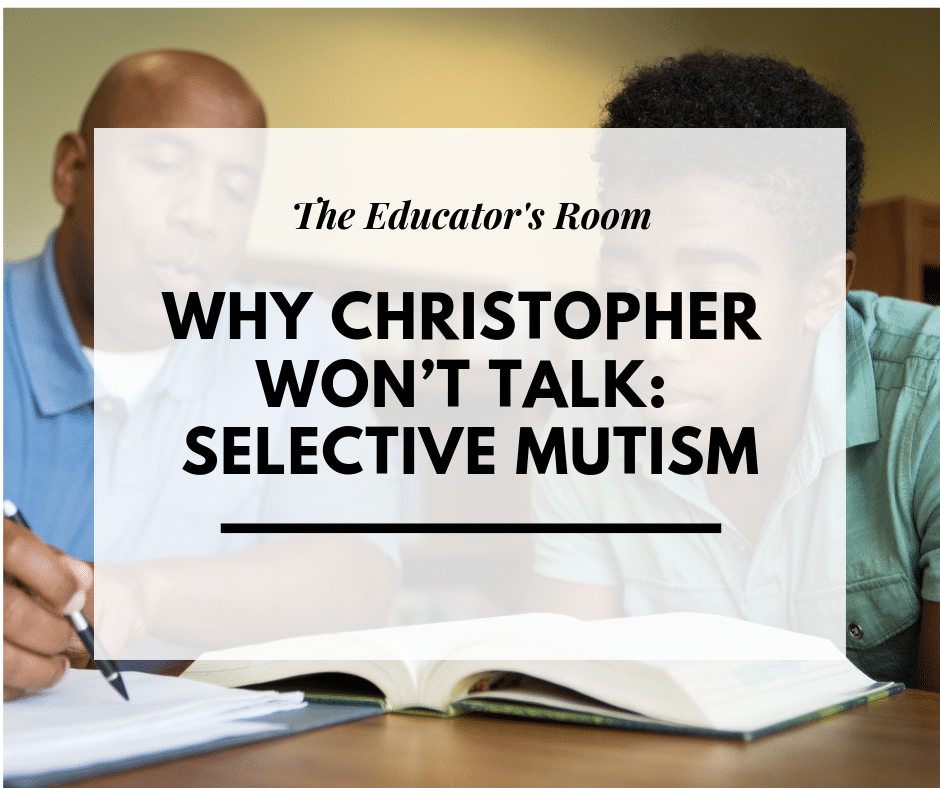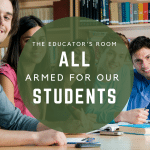Have you ever had a student in your class who did not talk? A student who never smiled, spoke out loud to you, to classmates, to anyone? A child who would not even whisper, gesture, laugh, or cry- not even at lunch or on the playground? If so, that child may have been more than just shy; they may have had Selective Mutism. Understanding what this disorder is and is not is key for teachers and parents who interact with the Selective Mutism (S.M.) child.
A little over two years ago, my youngest son was about to start preschool as a three-year-old. I knew that he was very shy and rarely talked in public. What I did not know was that he was petrified – beyond anxious- when he was expected to talk to anyone besides me, his father, and his older brothers.
The first day of preschool came and I had no clue that this adorable little man was so, so scared! He was in a classroom directly across from his older brother who was in the four-year preschool class. I was there all day, as I also worked at the school. At the end of the day, he had not smiled, talked, whispered- no communication at all. He barely gestured and could not tell his teachers that he had to use the bathroom. As a result, he had an accident and was mortified. He went all day without uttering a word or emotion.
Two months later, we took my son to the Kennedy Krieger Institute in Baltimore, MD. Christopher was diagnosed with Selective Mutism, a childhood anxiety disorder in which a child is mute in certain social situations, but talks comfortably in others. It is a very complex disorder that usually occurs before the age of five. These children have the ability to talk but become so paralyzed with fear in some social situations (usually at school), that they cannot talk or interact. Some refer to this disorder as a social communication anxiety disorder. Over 90% of children with Selective Mutism (S.M.) also have social phobia.
There are varying degrees of severity of S.M in children. Some do not talk at all and are totally non-communicative: they make no sounds (whisper, laugh, cry, grunt). Others may whisper to a friend, but not their teacher. Some will use hand gestures and nod their head when asked a question. Others will have a countenance marked by a look of fear, panic, and a frozen, stone-like stare. They may or may not interact with other children. My own child has not ever in three years talked out loud or whispered to any of his classmates at recess. On the other hand, some children, with the support of their parents, teachers, and therapists, have progressed to the point where they may be whispering, talking out loud, or interacting with the teacher.
What most of these children have in common is that at home they are quite talkative, happy, boisterous, and may even be quite social with neighborhood children. Why the stark difference? The reason is that when the child is out of their comfort zone (usually the home), they become so paralyzed with fear and anxiety that they physically cannot talk.
What does Selective Mutism look like?
Although there are many variances, some children, including my son, exhibit these symptoms:
• Extreme shyness in and out of the home – even with friends and relatives. Christopher would cling to me and hide his face when his grandparents would visit. He would not talk to his cousins or other relatives. The anxiety was worse when visiting others outside our home, at church, doctor appointments, or when shopping.
• A sober countenance marked by a look of fear, panic, seriousness, and a frozen stare
• No smiles
• Little to no gesturing- no pointing, nodding of the head, raising the hand, etc.
• A mute, withdrawn, unhappy child that does not interact with others. After two years, Christopher is doing parallel play at school instead of playing by himself- a major accomplishment.
• A happy, sometimes loud, boisterous, talkative, and social child in the home and with neighborhood friends
What Does Selective Mutism Sound Like?
Again, there are many degrees of the severity from child to child. With my own child, there was some inconsistency. Such as, he would talk at the doctor’s office if the appointment was for somebody else. If it was for him, he was mute.
• Some children may not speak at all- no sounds- no laughing or crying. They may cover their mouths to prevent even a giggle from escaping.
• Others may mouth or whisper to teachers or classmates, or other peers.
• Some may talk when out of ear-shot of teachers. My son has progressed to the point where he might talk once we walk out of the door at the end of the day. He might.
• Again, there is no consistency. However, what is consistent is in the morning, as soon as I open the car door, – boom! – he is mute. He now will whisper to me as we walk across the parking lot and into the school. Why the difference from the beginning to the end of the day? My belief is that this is because his anxiety is so very intense at the beginning of the day as he is anticipating his school day. He knows that he will not be able to be himself- a jovial, outgoing child who loves to sing at the top of his lungs.
• Some may only whisper to other children but not to the teacher.
Research supports that it is important that all professionals who work and interact with an S.M. child understand this complex disorder. From the outside, it may appear that these children are just “overly” shy, obstinate, manipulative, or have control issues. Looks are deceiving. These children are not exhibiting behavior issues. They have severe anxiety issues.
These sweet little ones desperately want to be themselves! Many of these children speak, yell, sing, and talk nonstop at home or in the backyard with neighborhood friends. We need to love on them while they are under our charge and help them break their silence!
Sources:
Easing School Jitters For the Selectively Mute Child by Dr. Elisa Shipon-Blum (2011)
Helping Your Child With Selective Mutism: Practical Steps to Overcome a Fear of Speaking by McHolm, Cunningham, Vanier (2005)

[/fusion_builder_column][/fusion_builder_row][/fusion_builder_container]






I’m a teacher. I have witnessed this fear on the face of one of my sixth grade students. Our staff is completely baffled. How do we get her to feel comfortable at school? Speaking is an important part of communication. I worry because she can’t even be sure her basic needs are met because she can’t communicate the need.
Hi Laura,
This is a baffling disorder! I used picture cards with my son, who at first wouldn’t even nod his head, point, or raise his hand. For instance, I placed pictures of a bathroom, water fountain, etc. on a ring. My son just needed to put the picture on his desk to communicate that he needed to use the bathroom. This might be a good start. Could your student write on a sticky note and place on her desk? Dialogue journals might be another age-appropriate option for this middle school student.
Thanks for the reply, Lauren! We tried picture cards, but she won’t use them. I think the journal is a great idea. She is attending summer school to start getting to know a couple of her teachers for next year. She has written notes to one of them already. Thanks for the suggestions!
You are so welcome, Laura! From my experience with my son, the less pressure that is placed on him to communicate the better. For example, for months his goal was to whisper and then eventually speak aloud in the parking lot at school. He refused to do so. Once I stopped reminding him of his goal, he started talking out loud as soon as he exited the school doors! Also, if I praise him too much for his “brave talking”, he gets embarrassed and will shut down and become mute. That is great that the student is attending summer school… the more they feel comfortable, accepted, and loved, the better chance they can start working on their goals. 🙂